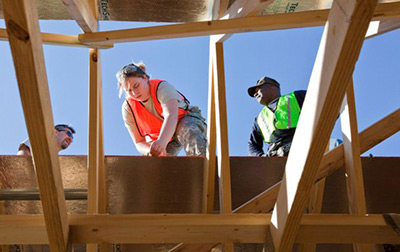
On a chilly December day, a dozen or so teenagers and adult volunteers worked side by side to build a Habitat for Humanity house for a worthy family. Community businesses and individuals sponsored the project, donated materials and, in just a little more than two weeks, produced a 48-by-24-foot home.

This house, however, is unlike any that Central South Carolina Habitat for Humanity has ever built. It was constructed by incarcerated youth from behind the razor-wire fence surrounding the Department of Juvenile Justice in Columbia. Teenagers who once took from their community are now giving back in a real way and gaining new skills and experiences while doing it.
DJJ director Margaret Barber calls the project a win-win for all sides. “I can’t think of a better thing for our kids to be doing. It is a classic restorative piece that gives these kids experience they’ve never had before. Building a house allows them to give something whole back to a community in which they have caused destruction. This is the house that DJJ built,” Barber said.
CSCH executive director Roy Kramer described it as one of the easiest community partnerships he’s seen come together. “It’s huge for Habitat to be able to tap into a resource like this, and it’s empowering for these young people. Building a house gives a young person a chance to work with their hands, learn a new skill, practice teamwork, and see a project from start to finish. And every person has had a smile from ear to ear.”

Sixteen-year-old Megan smiled as she talked about her part in building the Habitat house. “I get to help another family, and that makes me happy. It’s coming from our hearts. This is definitely a new experience for me building a house. It’s turning out beautiful,” she said.
The next step will happen Jan. 23, when two cranes will lift the house up and over the fence so that it can be placed in a Richland County neighborhood. Youth offenders who have been released on probation will work with more community volunteers to put the final touches on the home.
Barber credits volunteers with the success of DJJ community projects like this one. “Volunteers have given their hearts, dollars and time to this project,” she said. “We couldn’t do it without our community and volunteers who serve and work with us. Irene Murphy and South Carolina WMU have taken every opportunity to speak to and mentor the kids here, and they respond to them.”
Murphy, Woman’s Missionary Union DJJ consultant, said she is excited about what the Habitat project has to offer everyone involved. Time spent hammering nails alongside teenagers is time spent building relationships in which the gospel can be shared one day, she said.
“If we don’t forgive what got these kids behind the fence and put things behind us to reach them, they might end up in the ‘big house’ one day. Ministry to these kids is a ministry to the ‘least of these,’ ” Murphy said.
According to Mercy Clayton, WMU director at First Baptist Church, Easley, the project represents the heart of missions. When Clayton heard that the 45-member Habitat project crew needed lunch one day, she volunteered her WMU group to bring piping hot beef stew to the work site. “This is my first time behind the fence. Now I want to get involved and begin doing things here,” she said.
Clayton is not alone. Kramer said Habitat plans to teach the kids how to pre-build walls for Habitat house projects and how to build doghouses with leftover materials. “Seven doghouses can be made with the materials that remain from one house project, and we want to teach the kids how to build them. I am sure there will be other ideas we don’t even know about yet,” he said.
The homebuilding collaboration inspired Tom Capps, missions mobilization consultant with Greer Association, to think of a way churches can take the idea a step further.
“Wouldn’t it be great to figure out which communities these juveniles call home,” he said, “and send volunteers from that community behind the fence to work along with the youth on a house? Then, when the youth offenders are released, they can reconnect with the same volunteers who could introduce them to an entirely new kind of life.”
Barber, Kramer and Murphy agree the project represents a partnership that can be forged in any community. “The concept of building a house offsite can be challenging, but it boils down to community partnerships that help get that done,” Kramer said. “Juveniles are sitting right there in many communities, and they are excited and eager to learn about building a house. As successful as it was here, it should be done everywhere.” – SCBC
